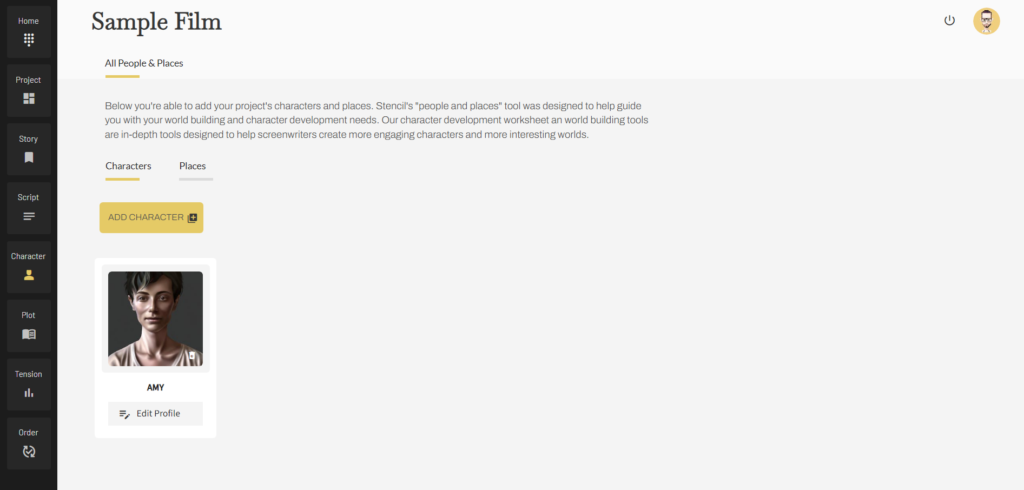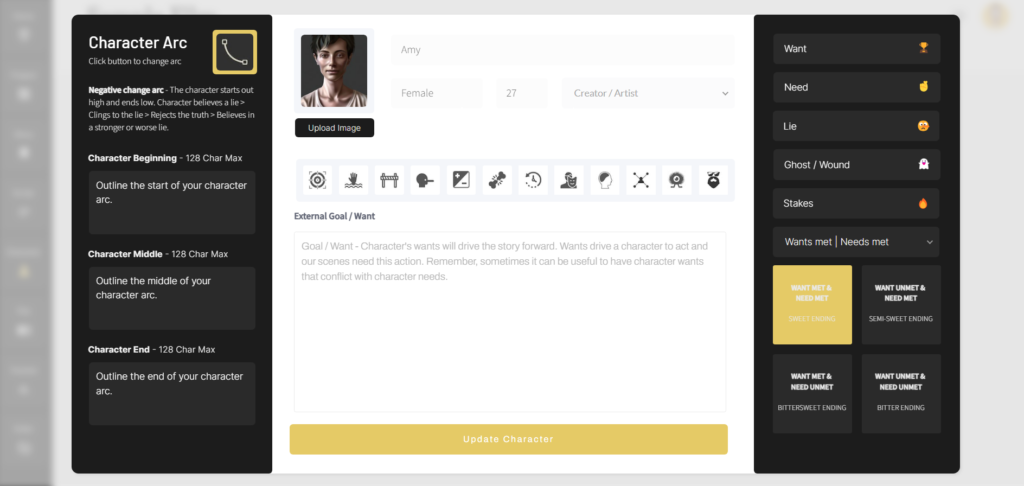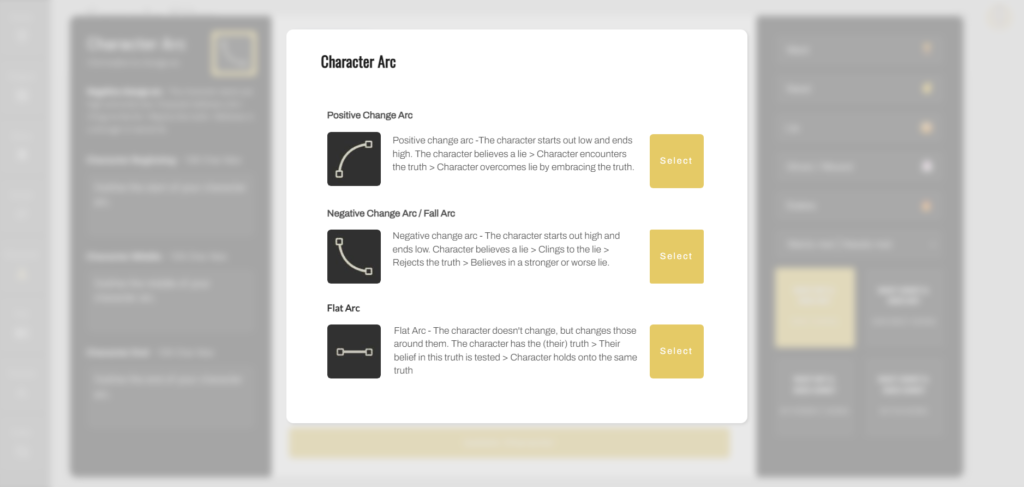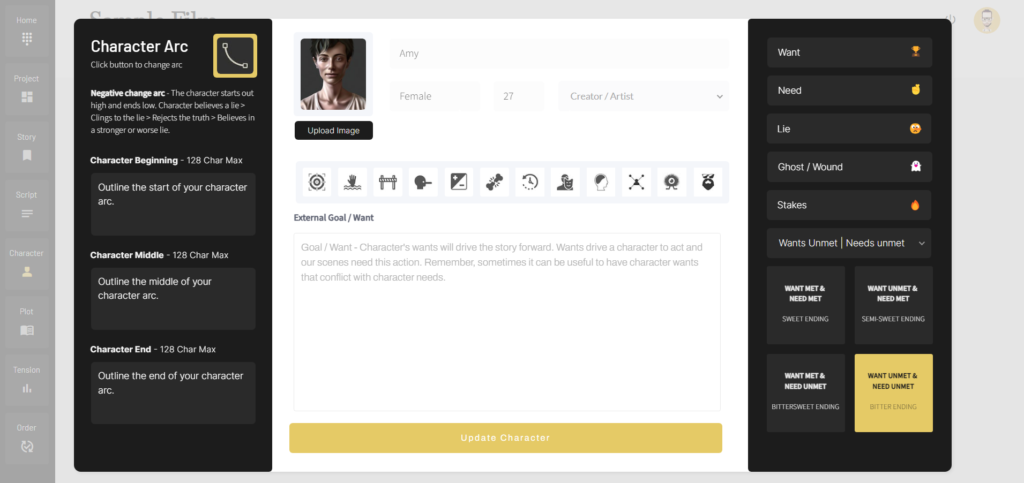STENCIL.ONE
Character Development Worksheet For Film
In this tutorial we’ll take a closer look at our character development worksheet which was designed to help you create much more engaging characters.
![]() Software version 1.1.1
Software version 1.1.1

Character Development Worksheet To Create Strong Characters
In today’s tutorial we’re going to learn about Stencil’s built-in 15 point character development worksheet. Let’s jump in.
The Art of Character
In the book, The Art of Character, author David Corbett states that:
Every Story worth telling in some way mirrors our lives, and to that extent explores four key questions:
Who am I?
Where do I come from?
Where am I going?
And What does it mean?
He continues later saying:
“We see in our characters reflections of ourselves, which is why we detect in their stories, no matter how fanciful or dark or grand, an attempt to better understand our lives. And what else is there to discuss, really, than our lives?”
Now if you don’t know, we’re Stencil, a screenwriting tool that helps writers create more compelling screenplays. And we’re a bit obsessed with character development. So in today’s tutorial I’m going to walk you through a character profile template designed to help you create deeper and more engaging characters.
Of course, you can map out your character profile using a pencil and a piece of paper, but I’m going to do this over in Stencil. If you want to follow along, then just login and create a new project or click on an existing one, and then click over to “characters”. When you start the process of creating a new character, you’ll see the character profile template. Or you can click on “edit” for any existing characters you have.

So let’s start going through each of these items in more detail.
Want
Near the bottom of the popup you’ll see your main character profile template section. You can hover over each icon to see what each icon represents. I’m going to begin by clicking on this first icon which is the character’s “external want”. This character “want” is the “thing” that your character will quest towards in your story.

Need
Next, we have the character’s internal “need”. Need is different than want. Although they might seem similar, keep in mind that there is often quite a bit of friction between want and need.
We have an entire tutorial dedicated to this topic with examples over on our filmmaking blog, but let me just give you a quick example, so that you understand the difference between character want and need.
In the film, The Lost City of Z, the protagonist, Percy Fawcettt “wants” to go on an expedition to find a lost world in the middle of the Amazon jungle. Again, this “external want” is what propels the action forward.
However, there is something subtler below the surface that makes the story more interesting. Remember, your “external want” moves the character from point “A” to point “B”, but the underlying “internal need”, which is often not explicitly stated, especially not early on, is what the character is really striving towards their “want” for.
Think of the “need” as the “why” behind the “want”. However the “want” is obvious to both the main character as well as the film’s audience, while the need often exists at a subconscious or barely conscious level both within the main character as well as the audience.
Therefore, in the lost City of Z, the protagonist was questing towards his “want”, the discovery of a lost world, because he had an unmet “need” for recognition and respect. He believes that finding his “want” will satisfy his “need”. However, the character never makes it out of the jungle alive. Essentially, his “want” stopped him from achieving his “need”. And this is what I mean, when I said there is often friction between these two character design elements.
Obstacles
Next, we have obstacles. Obstacles are the things that get in your protagonist’s way during their quest towards their want. Without a “want”, it’s kind of hard to put things in the way, and that’s why you generally establish want and need first.
After that, you can think creatively about how you can place your characters “want” just outside of their reach, which means they will need to “work for it” in order to get it.
For example, In the lost City of Z, the protagonist finds himself fighting off starvation in the middle of the jungle. He finds himself under attack by local tribes. He finds himself negotiating and failing at getting the funding necessary for his expeditions… and the list goes on. These obstacles are designed specifically to impede your protagonist’s progress towards their goal.
Lie
Next, we have the character lie, which is the misbelief your character tells themselves about how the world works. Sometimes this stops them from being able to see their true internal needs and often, it propels them, in a kind of misguided way, towards their external want. A good character lie is often constructed as a subtle and elusive antagonistic force within the story.
Contradictions
Next, we have contradictions. To flesh out your characters it’s important to understand how they behave under different circumstances – physically, emotionally and morally. How is your character different at church compared to how they behave amongst friends? How do your characters navigate the seemingly incompatible parts of their personality? Contradiction is everywhere, within all of us. Find it within your character.
Ghost
Next, we have the “ghost” or the “wound”. This is the thing that makes the protagonist vulnerable. It takes place before the story begins, but it’s the thing that holds the character back and follows them around like a shadow or a ghost. Think about past traumas which haunt the protagonist but contribute to their personality. These ghosts are also often the source of the character’s misbelief or lie. Those misbeliefs don’t get formed out of nothing, and they often have their source as this ghost or wound. So ask yourself, what wounds are your character’s carrying around with them?
Character Backstory
Next, we have our backstory. Our backstory allows us to explore who our character’s were in the past. What parts of their past pushed them forward and inspired them or traumatized them to make them the people who they are today? Backstory can help readers emotionally invest in your character, even if your character leaves a lot to be desired, because we can see where the character’s are coming from and it helps us to understand why they behave the way they do.
Character Mask
Next up we have the character’s mask. The mask is the character’s ego. The mask is the identity the character wants to project out into the world. It’s a way for the character to control how they are perceived by others. How they dress and behave in different settings allows them to show off their mask.
Through the mask, they try to tell the world something about themselves. But why does your character want to express this mask to the world? We need to ask not only what the mask conceals about our character’s weaknesses and hides about their “secret self”, but also what type of rejection the mask protects the character against.
Psychology
Next, we have the inner core, or the psychological make-up of the character. This is essentially your character’s inner life. Their emotions, feelings, passions, fears, hates and hopes.
Sociology
Next, we have sociology. This is similar to psychology, but instead of an exploration of the character’s inner world, we look at how the character thinks and behaves socially. How does your character interact with the real world, and other people specifically? How do they deal with guilt, shame and failure in the public realm?
Quirks
Next, we have quirks. These are the little ticks that make your character unique. They could be catch phrases, mannerisms, bad habits and so on. We all have them. So pull your character’s quirks out.
Appearance
Lastly, we have character appearances. In this section here you can talk about how your character looks and dresses.
Character Arc
Next, we have to determine the character arc. I tend to find knowing this early on helpful when writing. Are you working with a character with a positive change arc, a negative change arc or a flat character arc? In the future, we’ll publish a tutorial dedicated to this topic exclusively, but when you’re using a character profile template to create a character, it’s helpful to know the character’s arc beforehand.

Over to the right of your character development template, just as a quick reference, you can place short one-liners for wants, needs, lies and ghosts.
And then next we have stakes.
Character Stakes
Stakes are simply what your character stands to lose if they don’t accomplish their goal. Your character has to gamble something. If they fail, they can’t end back up where they were, They have to end up in a worse situation.
And we need to consider two levels of stakes here. Because we have the stakes associated with our external goal, but we also have stakes associated with our character’s internal need. What will be the consequences of not satisfying the character want? What will the consequences of not satisfying the character’s internal need be? And will there be times, both internally and externally, where there will be moral no-win situations, where essentially your character will have to engage in some trade off between the lesser of two evils. We can learn a lot about our characters when they are confronted with complex stakes like this.
Character Ending Quadrant
Lastly, on our character profile template here, we can pre-plan our ending. This quadrant ties a lot of what we’ve talked about so far together. Essentially, we have 4 possible endings. Will the character achieve their external want and internal need resulting in a happy-ending? Will the character achieve their need but not their want, or vice versa, resulting in an unresolved semi-happy ending. Or will the character have unmet wants and unmet needs by the end of the story resulting in a tragic ending? Again, knowing this before you start writing, can really help with plotting your story early on.

Conclusion
So that’s a Stencil’s character profile template in a nutshell.
And remember, if you want to use this character profile template or any of our other character development tools, simply head over to our homepage to sign up for a free trial.
Once you’re logged in, you simply need to add a new project… then click over on “characters” in the sidebar and then start adding characters.
Also, remember to come back to our filmmaking blog often, as we regularly publish new tutorials for filmmakers and screenwriters.
So that’s all I have for you today!
Thanks for stopping by!

All-In-One Film Production Software
Stencil comes will all of the tools you need to manage your film production studio. We help you manage storytelling, budgeting, casting, location scouting, storyboarding and so much more!
![]() Software version 1.1.1
Software version 1.1.1

A software solution designed to help filmmakers complete compelling stories.
![]() Version 1.1.1
Version 1.1.1
USE CASES
Feature Films
Documentaries
Shorts
Music Videos
Commericals
Fashion Films